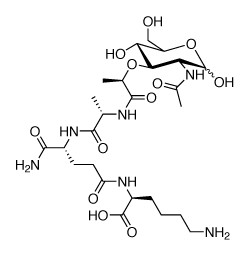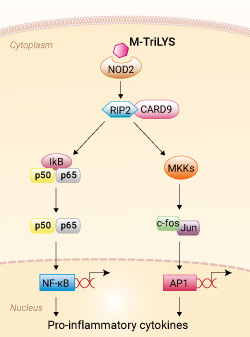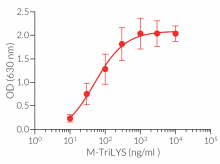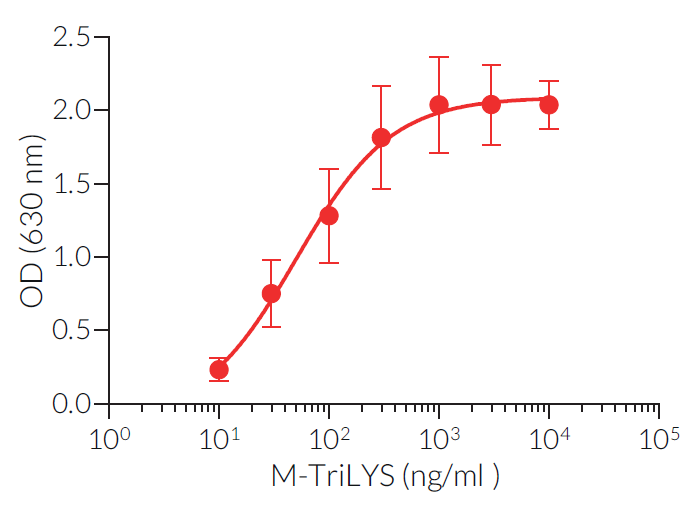M-TriLYS
| Product | Unit size | Cat. code | Docs. | Qty. | Price | |
|---|---|---|---|---|---|---|
|
M-TriLYS NOD2 Agonist - Synthetic muramyl tripeptide |
Show product |
1 mg |
tlrl-mtl
|
|
NOD2 Agonist - Synthetic muramyl tripeptide
M-TriLYS (MurNAc-Ala-D-isoGln-Lys) is a chemically synthesized muramyl tripeptide. It is an agonist of the cytosolic receptor NOD2 [1]. NOD2 acts as a general sensor of bacterial invasion [2, 3].
Mode of action:
Upon agonist binding, NOD2 oligomerizes and signals via RIP2 kinase. Once activated, RIP2 mediates ubiquitination of NEMO/IKKγ leading to the activation of NF-κB and the production of inflammatory cytokines. Furthermore, poly-ubiquitinated RIP2 recruits TAK1, which leads to IKK complex activation and the activation of MAPKs. This signaling involves the adaptor protein CARD9.
Of note, M-TriLYS has been shown to produce the anti-inflammatory cytokine IL-10 and protect mice from colitis [1].
Key features:
- Potent NOD2 agonist
- Synthetic muramyl tripeptide
- Each lot is functionally tested
![]() Read our review on NOD-Like Receptors
Read our review on NOD-Like Receptors
Reference:
1. Macho Fernandez E. et al., 2011. Anti-inflammatory capacity of selected lactobacilli in experimental colitis is driven by NOD2-mediated recognition of a specific peptidoglycan-derived muropeptide, Gut, 60: 1050 - 1059.
2. Girardin S.E. et al., 2003. Nod2 is a general sensor of peptidoglycan through muramyl dipeptide (MDP) detection. J Biol Chem. 278(11):8869-72.
3. Inohara N. et al., 2003. Host recognition of bacterial muramyl dipeptide mediated through NOD2. Implications for Crohn’s disease. J Biol Chem. 278(8):5509-12.
Back to the top
Specifications
Specificity: NOD2 agonist
Working Concentration: 100 ng - 10 µg/ml
Synonym: MurNAc-Ala-D-isoGln-Lys
Molecular weight: 620.65 g/mol
Solubility: 1 mg/ml in water
Quality Control:
- Activation of NOD2 has been confirmed using HEK-Blue™ NOD2 cells.
- The absence of NOD1 activity has been confirmed using HEK‑Blue™ NOD1 cells.
- The absence of bacterial contamination (e.g. lipoproteins and endotoxins) has been confirmed using HEK-Blue™ TLR2 and HEK‑Blue™ TLR4 cells.
Contents
- 1 mg M-TriLYS provided lyophilized
- 1.5 ml sterile endotoxin-free water
![]() M-TriLYS is shipped at room temperature.
M-TriLYS is shipped at room temperature.
![]() Upon receipt, store lyophilized product at -20˚C.
Upon receipt, store lyophilized product at -20˚C.
Details
NOD1 and NOD2
The cytosolic NOD-Like Receptors (NLRs, also known as NODs or NALP) are Nucleotide-binding Oligomerization Domain containing receptors. To date, 22 NLRs have been identified in humans and constitute a major class of intracellular pattern recognition receptors (PRRs) [1].
The founding NLR-family members NOD1 (CARD4) and NOD2 (CARD15) recognize distinct motifs of peptidoglycan (PGN), an essential constituent of the bacterial cell wall. NOD1 senses the D-γ-glutamyl-meso-DAP dipeptide (iE-DAP), which is found in PGN of all Gram-negative and certain Gram-positive bacteria [1, 2] whereas NOD2 recognizes the muramyl dipeptide (MDP) structure found in almost all bacteria. Thus NOD2 acts as a general sensor of PGN and NOD1 is involved in the recognition of a specific subset of bacteria. Both iE-DAP and MDP must be delivered intracellularly either by bacteria that invade the cell or through other cellular uptake mechanisms. Ligand-bound NOD1 and NOD2 oligomerize and signal via the serine/threonine RIP2 kinase through CARD-CARD homophilic interactions [3]. Once activated, RIP2 mediates ubiquitination of NEMO/IKKγ leading to the activation of NF-κB and the production of inflammatory cytokines. Furthermore, poly-ubiquitinated RIP2 recruits TAK1, which leads to IKK complex activation and the activation of MAPKs [4].
Genetic mutations in NOD2 are associated with Crohn’s disease, a chronic inflammatory bowel disease [5]. In addition, numerous studies have recently revealed that NOD1 and NOD2 have a close relationship with a variety of cancers via controlling proliferation, altering immunosurveillance, and interacting with tissue bacteria, including intestinal commensal intestinal microflora. Moreover, additional research into the mechanisms of NOD1 and NOD2 in cancers would shed light on the innate immunity-cancer relationship and provide intriguing targets for immunotherapy [6].
References:
1. Chamaillard M. et al., 2003. An essential role for NOD1 in host recognition of bacterial peptidoglycan containing diaminopimelic acid. Nat. Immunol. 4: 702-707.
2. Girardin S. et al., 2003. Nod1 detects a unique muropeptide from Gram-negative bacterial peptidoglycan. Science 300: 1584-1587.
3. Kobayash, K. et al., 2002. RICK/Rip2/CARDIAK mediates signalling for receptors of the innate and adaptive immune systems. Nature 416: 194-199.
4. Kobayashi K. et al., 2005. Nod2-dependent regulation of innate and adaptive immunity in the intestinal tract. Science 307: 731-734.
5. Ogura Y. et al., 2001. A frameshift mutation in NOD2 associated with susceptibility to Crohn’s disease. Nature 411: 603-606.
6. Wang D., 2022. NOD1 and NOD2 Are Potential Therapeutic Targets for Cancer Immunotherapy. Comput Intell Neurosci.;2022:2271788.
Structure of M-TriLYS:








